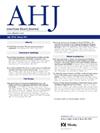Comparative Cardiovascular Outcomes of Tirzepatide vs Liraglutide in Obese Patients with Sleep Apnea: A Propensity-Matched Analysis Using the TriNetX Research Network
IF 3.5
2区 医学
Q1 CARDIAC & CARDIOVASCULAR SYSTEMS
引用次数: 0
Abstract
Background
Both tirzepatide (a dual GIP/GLP-1 receptor agonist) and liraglutide (a GLP-1 receptor agonist) have demonstrated cardiometabolic benefits, but their comparative cardiovascular outcomes in high-risk populations remain poorly characterized. This study compared mortality and cardiovascular outcomes between obese patients with sleep apnea treated with tirzepatide versus liraglutide.
Methods
We performed a retrospective cohort study using the TriNetX Global Collaborative Network, analyzing data across 128 healthcare organizations. Obese patients (BMI ≥30 kg/m²) with sleep apnea who were prescribed either tirzepatide or liraglutide were identified. After propensity score matching for demographics and comorbidities, cohorts of 21,356 patients each were analyzed. The primary outcome was all-cause mortality. Secondary outcomes included cardiac events, arrhythmias, and other clinical outcomes. Outcomes were assessed using risk analysis, Kaplan-Meier survival analysis, and number of instances analysis over a five-year follow-up period.
Results
Tirzepatide use was associated with significantly lower all-cause mortality compared to liraglutide (0.7% vs 1.4%; risk ratio [RR] 0.479, 95% CI 0.394-0.582; p<0.001). Tirzepatide-treated patients also had reduced risks of heart failure (RR 0.658, 95% CI 0.583-0.743), atrial fibrillation (RR 0.706, 95% CI 0.605-0.823), ventricular tachycardia (RR 0.749, 95% CI 0.585-0.958), and cerebrovascular disease (RR 0.781, 95% CI 0.683-0.893). Additionally, tirzepatide was associated with lower risks of acute kidney injury, hypertension, coronary artery disease, and peripheral arterial disease (all p<0.05).
Conclusion
In obese patients with sleep apnea, tirzepatide was associated with significantly lower all-cause mortality and reduced cardiovascular events compared to liraglutide. These findings suggest potential cardiovascular advantages of dual GIP/GLP-1 receptor agonism over GLP-1 receptor agonism alone in this high-risk population.
比较替西帕肽和利拉鲁肽在肥胖睡眠呼吸暂停患者中的心血管结局:使用TriNetX研究网络的倾向匹配分析
研究背景:替西肽(一种双GIP/GLP-1受体激动剂)和利拉鲁肽(一种GLP-1受体激动剂)均已证实对心脏代谢有益,但在高危人群中,它们的心血管预后比较仍不清楚。这项研究比较了肥胖睡眠呼吸暂停患者使用替西帕肽和利拉鲁肽治疗的死亡率和心血管结局。方法我们使用TriNetX全球协作网络进行了一项回顾性队列研究,分析了128家医疗机构的数据。肥胖患者(BMI≥30 kg/m²)伴有睡眠呼吸暂停,使用替西帕肽或利拉鲁肽。在对人口统计学和合并症进行倾向评分匹配后,分析了21356名患者的队列。主要结局为全因死亡率。次要结局包括心脏事件、心律失常和其他临床结局。使用风险分析、Kaplan-Meier生存分析和5年随访期间的病例数分析来评估结果。结果与利拉鲁肽相比,使用舒帕肽的全因死亡率显著降低(0.7% vs 1.4%;风险比[RR] 0.479, 95% CI 0.394-0.582; p<0.001)。替西肽治疗的患者心衰(RR = 0.658, 95% CI = 0.583-0.743)、房颤(RR = 0.706, 95% CI = 0.605-0.823)、室性心动过速(RR = 0.749, 95% CI = 0.585-0.958)和脑血管疾病(RR = 0.781, 95% CI = 0.683-0.893)的风险也降低。此外,替西肽与较低的急性肾损伤、高血压、冠状动脉疾病和外周动脉疾病风险相关(p < 0.05)。结论在伴有睡眠呼吸暂停的肥胖患者中,与利拉鲁肽相比,替西帕肽能显著降低全因死亡率和心血管事件。这些发现表明,在高危人群中,双GIP/GLP-1受体激动剂比单独GLP-1受体激动剂有潜在的心血管优势。
本文章由计算机程序翻译,如有差异,请以英文原文为准。
求助全文
约1分钟内获得全文
求助全文
来源期刊

American heart journal
医学-心血管系统
CiteScore
8.20
自引率
2.10%
发文量
214
审稿时长
38 days
期刊介绍:
The American Heart Journal will consider for publication suitable articles on topics pertaining to the broad discipline of cardiovascular disease. Our goal is to provide the reader primary investigation, scholarly review, and opinion concerning the practice of cardiovascular medicine. We especially encourage submission of 3 types of reports that are not frequently seen in cardiovascular journals: negative clinical studies, reports on study designs, and studies involving the organization of medical care. The Journal does not accept individual case reports or original articles involving bench laboratory or animal research.
 求助内容:
求助内容: 应助结果提醒方式:
应助结果提醒方式:


